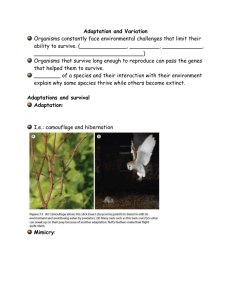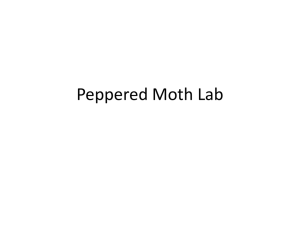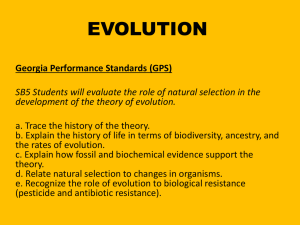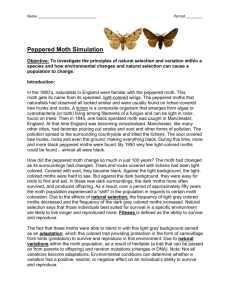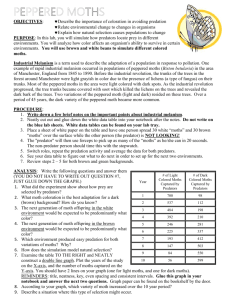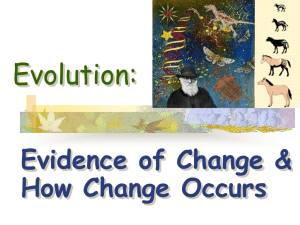Topic 5.4 Evolution (IB)
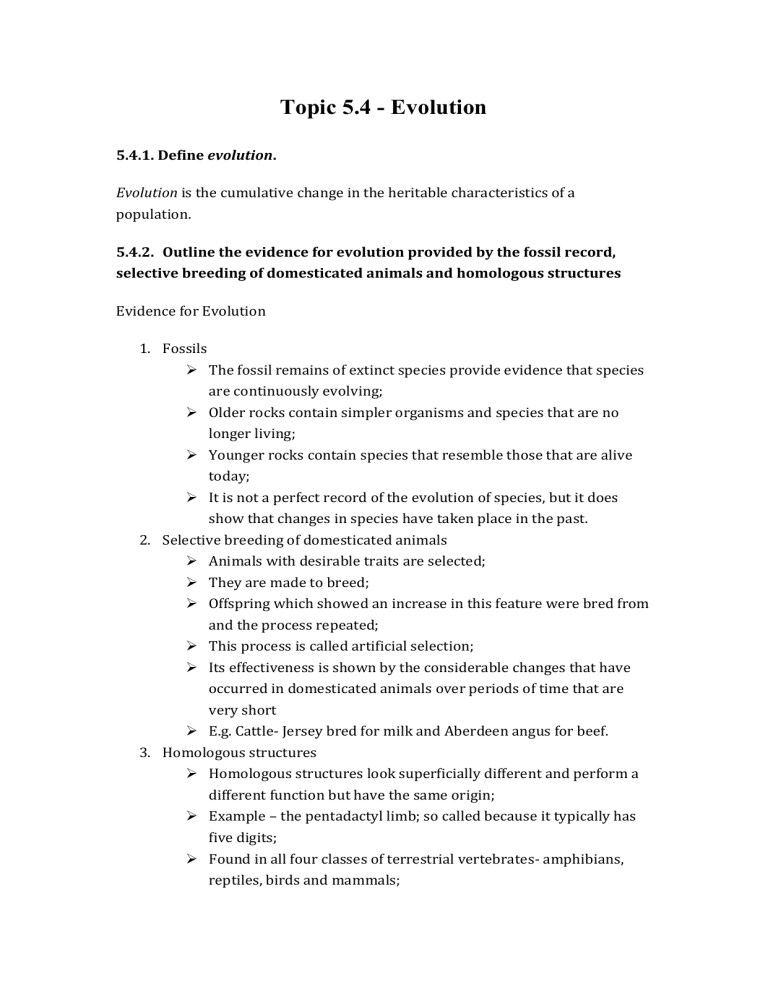
Topic 5.4 - Evolution
5.4.1. Define evolution.
Evolution is the cumulative change in the heritable characteristics of a population.
5.4.2. Outline the evidence for evolution provided by the fossil record, selective breeding of domesticated animals and homologous structures
Evidence for Evolution
1.
Fossils
The fossil remains of extinct species provide evidence that species are continuously evolving;
Older rocks contain simpler organisms and species that are no longer living;
Younger rocks contain species that resemble those that are alive today;
It is not a perfect record of the evolution of species, but it does show that changes in species have taken place in the past.
2.
Selective breeding of domesticated animals
Animals with desirable traits are selected;
They are made to breed;
Offspring which showed an increase in this feature were bred from and the process repeated;
This process is called artificial selection;
Its effectiveness is shown by the considerable changes that have occurred in domesticated animals over periods of time that are very short
E.g. Cattle- Jersey bred for milk and Aberdeen angus for beef.
3.
Homologous structures
Homologous structures look superficially different and perform a different function but have the same origin;
Example – the pentadactyl limb; so called because it typically has five digits;
Found in all four classes of terrestrial vertebrates- amphibians, reptiles, birds and mammals;
All of them have the same bones in the same relative positions, despite on the surface appearing completely different;
The evolutionary explanation is that they have had the same origin, from an ancestor that had a pentadactyl limb , and that they have become different because they perform different functions.
5.4.3. State that populations tend to produce more offspring than the
environment can support.
5.4.4. Explain that the consequence of the potential overproduction of
offspring is the struggle for survival.
Organisms produce many more offspring than can live off of these limited resources.
Therefore, there is a struggle to survive between offspring.
This allows for natural selection, because those best suited for their environment survive and pass on their better-suited genes.
5.4.5. State that the members of a species show variation.
Members of a species that reproduce sexually show much variation;
Those species that show variations most adapted to the environment are more likely to survive.
5.4.6 Explain how sexual reproduction promotes variation in a species.
> Meiosis results in the formation of gametes;
> Random assortment of chromosomes in metaphase I occurs;
> This gives rise to a variety of haploid gametes;
> Crossing over may occur between homologous chromosomes in prophase 1;
> This causes new combination of genetic alleles;
> Non-disjunction can cause change in chromosome numbers resulting in variation of the gametes;
> Random fertilization results in variation in species;
> Mutation can occur in prophase 1 to cause variation in a species.
5.4.7.
Explain how natural selection leads to evolution.
Parents produce more offspring than required to keep numbers constant;
More are produced that the environment can support;
Thus there is struggle for existence due to limited food and space ;
Some are better adapted than others to the environment;
The ones with the more successful characteristics survive . This is survival of the fittest, these offspring show variation;
These tend to survive to breed themselves;
These characteristics are inheritable;
So the new generation has these characters too;
This leads to changes in the population as a whole;
These changes constitute evolution;
5.4.8. Explain two examples of evolution in response to environmental
change; one must be antibiotic resistance in bacteria
Example 1- Antibiotic resistance in bacteria
Members of the population of the same species show variation;
Members with an advantageous genetic trait survive in that environment (survival of the fittest);
These genetic traits may be heritable;
They are passed on to the offspring and this can change the characteristic of the population;
Bacteria are normally killed by antibiotics, which impose a selective pressure in the population of bacteria;
If a few bacteria have natural resistance to the antibiotic they will survive;
If this gene for resistance is heritable, they will pass it to their offspring. This process will repeat;
Finally, bacterial colonies resistant to antibiotics evolve, e.g. resistant TB bacteria.
Example 2- Melanism in moth
Two varieties of the moth Biston betularia exist in the forms of different body color;
One is black, the other is speckled. Predators easily see the black moth while the speckled one is camouflaged;
When on a tree covered in lichens, the peppered moth blends in very well. The number of speckled moths was greater than the number of black moths, because the speckled genes made the speckled moths more suitable for their environment of lichencovered trees.;
Because they were able to camouflage, they could evade predators more than black moths could, which allowed them to reproduce more moths with the genes for speckled color.;
Then, the trees began to get covered in soot due to industrialization, and the black moth was able to be more camouflaged than the speckled moths;
Because of this, more black moths than speckled moths evaded predators, allowing them to produce more black moths. So the population of black moths then increased and the speckled moth population decreased.

